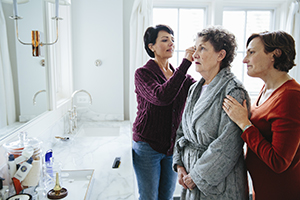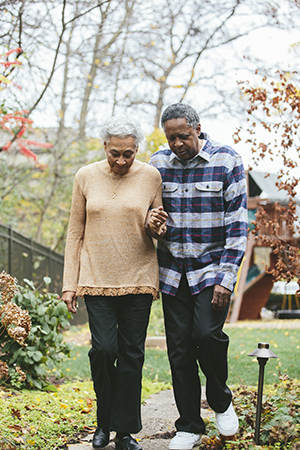North Bay caregiver makes home safety a priority
For Caregiver month we’re highlighting Elenita, a caregiver in the North Bay. This is the second part of a two-part series. The first part, about the benefits of finding a support group, is available here.
Between evacuating for two wildfires and the progression of her husband’s Alzheimer’s disease, Elenita takes her husband Dennis’ safety very seriously. She shares her tips on how she has made her home safer for Dennis as well as how to be better prepared should they need to evacuate their home again.

Finding a support group
Elenita’s husband Dennis was a financial planner in the North Bay until he retired, due to bladder cancer in 2015. Elenita had started noticing some odd behavior from Dennis and so they went to see a doctor. After two assessments, Dennis was diagnosed with Alzheimer’s disease in 2016.
Through the process of working with neurologists, Elenita and Dennis were introduced to the Alzheimer’s Association® and were able to participate in an Early-Stage Support Group. The information she learned from others in the group helped her better prepare for Dennis’ safety needs as the disease progresses.
Keeping your loved one safe at home
People with Alzheimer’s or other dementia can live in their homes, as long as safety measures are in place. As Alzheimer’s progresses, a person’s abilities change. With some creativity and problem solving, you can adapt the home environment to support these changes. The Alzheimer’s Association offers many suggestions on the website.
Here are some general home safety tips to begin with:
- Secure all medications and supplements to reduce the chance of accidental ingestion
- Secure alcohol, matches/lighters, knives/scissors/blades, and cleaning supplies/chemicals
- Remove all guns and other weapons from the home or have them securely locked up
- Secure all car keys
- Make sure there is adequate lighting throughout the home and use motion sensing LED night lights as appropriate
- Simplify or declutter the environment the person with dementia spends their time in
- Set the hot water heater temperature to 120F
- Remove or tape down trip hazards such as area rugs or electrical cords
- Have a spare house key in an outside lockbox or with a neighbor
- Have copies of important legal and financial documents in a safe, convenient place and/or copies outside the home with another family member or trusted individual
Updating the bathrooms
Elenita is an observant caregiver who seems to be two steps ahead of a potential problem. Knowing that Dennis’ Alzheimer’s will continue to get worse, she doesn’t want him to have trouble with bathing.

In addition to installing strategically located grab bars, she’s also updating the shower. “We’re removing the tub from the main bath,” said Elenita. “Instead, we’re installing a walk-in shower that has a flat entry, with no lip. We’re also removing the carpet from our other bathroom and installing tile.”
Bathroom safety equipment can be added to any bathroom to make bathing and toileting more accessible. Transfer benches or shower chairs, grab bars, and handheld shower heads can help in the bath/shower. Grab bars and toilet seat risers can help with toileting. Bathroom safety products can be found at any hardware store or at the alzstore.com.
Preparing for Wandering
Six in 10 people with dementia will wander. A person with Alzheimer’s may not remember his or her name or address, and can become disoriented, even in familiar places. Wandering among people with dementia is dangerous, but there are strategies and services to help prevent it.
Recently, Dennis went on a walk without telling Elenita. Because of this, she has already begun to research different tools that can help her locate him should he get lost. “There will be a door alarm in our future,” said Elenita. “I’m also going to put some inserts [with GPS trackers] in his shoes so I know where he is.”
Elenita thought she could use a Tile tracker but the range wasn’t far enough for her. However, it can still be useful for finding misplaced items within the home. There’s even a tracker that is small enough to be put on a phone or tv clicker, which are often misplaced items.
ID bracelet
Elenita purchased an ID bracelet for Dennis. “It’s great for if you’re traveling or if he gets lost,” said Elenita. “You can get it as a bracelet or a necklace. Dennis’ bracelet has his name and my phone number on it. Then he can call or point to it for someone to help him call me.”
The Alzheimer’s Association, in collaboration with MedicAlert®Foundation, provides membership plans with 24/7 Wandering Support. Our nationwide emergency response service facilitates the safe return of individuals living with Alzheimer’s disease or another dementia who wander or have a medical emergency.

Troubleshooting wandering
Getting lost or accidentally wandering can occur at any stage in the disease. It’s helpful to try to understand the reason behind the wandering is the person living with dementia bored, scared, looking for something or someone, living out a pattern from the past, or trying to satisfy a basic need?
The Alzheimer’s Association website has many tips on how to prevent wandering. Having a routine for the person living with dementia that includes activities, physical activity, and respite for the caregiver can help reduce the risk of wandering.
Here are some ways you can adjust the physical environment in your home that may help deter your loved one from leaving:
- Camouflaging doors with posters
- Installing door alarms
- Covering the doorknob with a scarf
- Labeling interior doors to help orient the person living with the disease
- Removing triggers such as a purse hanging by the door
Evacuation plan
Because of the recent fires in California, specifically in the North Bay, Elenita and Dennis have a plan in place should they need to evacuate. “We’ve been evacuated twice,” said Elenita. “First with the Kincade Fire, and most recently, the Walbridge Fire. The first time, I didn’t want him to worry, so I packed irreplaceable items myself. Now he’s more used to the process and is more involved with decisions.”
Now that Elenita has had some experience with evacuating she has a plan in place should it happen again. “I have a list,” said Elenita. “I bold print the things that have to go. Anything that is really important, sentimental, or irreplaceable. I know what to grab first if I’m in a hurry or next if I have more time.”
While the Alzheimer’s Association provides a detailed list of items to include in an emergency kit, here are some of the most important items you should have should you need to evacuate:
- Legal, financial and medical documents
- Durable Powers of Attorney
- Advanced Directives
- Bank and saving account information
- Insurance information
- Prescriptions lists.
- A recent picture of the person living with dementia in case you become separated during the evacuation
Stay calm
Another thing Elenita has learned is to remain calm when you’re packing up papers and your belongings. “People living with the disease take a lot off of our mood,” said Elenita. “If you’re nervous then they get that way. This last time, I had Dennis watch a baseball game while I did all my hustling. He knows I’m packing, and I’ll ask him questions to keep him involved.”
Elenita reminds you to think about what is replaceable and what isn’t. If it’s something that can easily be replaced it might not be worth bringing. She also encourages you to remember to bring those things that make caring for your loved one easier, especially if it is an item that comforts the person living with dementia such as a favorite sweater, blanket or puzzle. These items can provide comfort and familiarity in a stressful situation.
Visit our website to find more information on home safety, wandering and evacuating. You can also find other home safety check lists from both the Mayo Clinic and the National Institute on Aging.
Learn more:

















